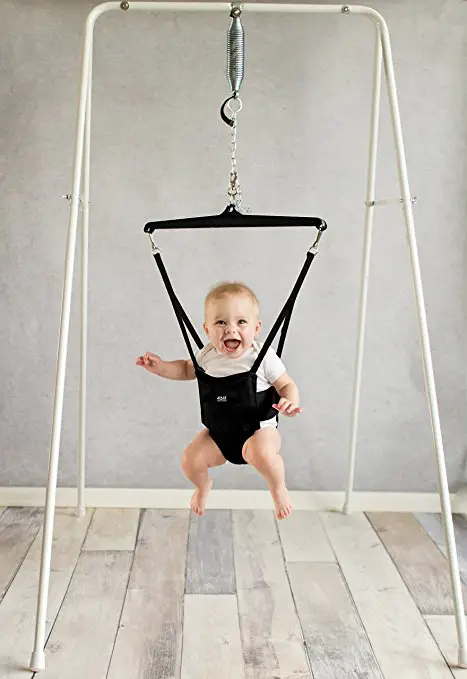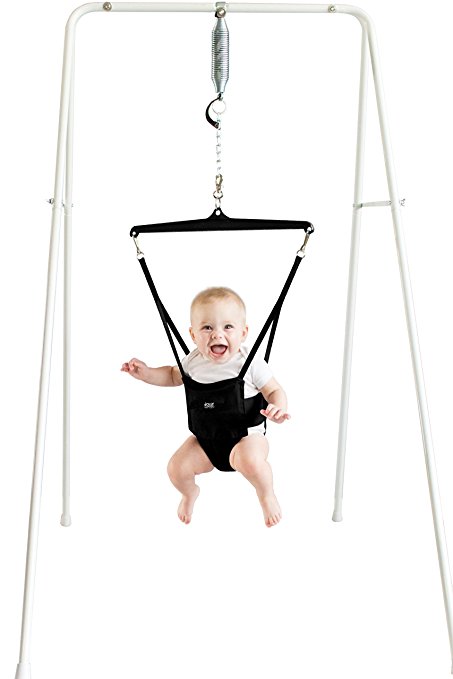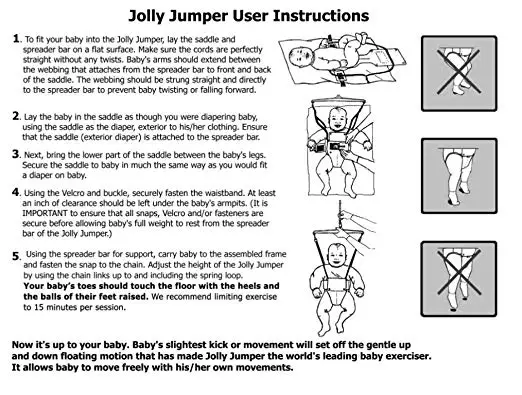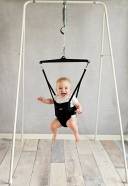Jolly Jumper Baby Exerciser Review: Is It Safe for your Baby?
We like
- Develops muscles in the legs and back
- Helps baby learn how to walk
- Builds coordination in the body
- Develops motor skills for crawling and playing
- Can be used indoors or outdoors
- The stand is slip-proof to ensure extra safety
We don’t like
- Has a weight limit that may be reached before one year old
- Some babies find it uncomfortable and won’t use the jumper
How it works
The Jolly Jumper has been considered a great device for kids who are learning how to walk or who love to exercise and move. The jumper is a safety harness that kids get strapped into and then the harness is strung up on a stand that can be placed anywhere. The harness allows babies to “stand” upright and jump. The harness also has the freedom to rock, which gives babies the feeling as if they are walking, which helps them develop the muscles and balance necessary to take their first steps. Babies can also develop motor skills and coordination as they spend time in the Jolly Jumper that, to them, is simply a fun toy.
Design
The Jolly Jumper is a harness that your baby gets clipped into. The harness is then attached to what appears to be an upside down hanger that resembles an inverted triangle. That triangle gets attached to the rope that is attached to the stand. Once the rope and the triangle are attached, your baby can then start to jump and play and pretend to walk. The overall design of the Jolly Jumper is quite simple and can be placed anywhere indoors and outdoors. The jumper does not come with any fancy colors or designs. The entire jumper is just the harness and the stand. Some Jolly Jumpers come with a clip system that allows you to clip the jumper onto the door jamb. This version is more advanced and safer.
Safety
Your baby should always be supervised when they are using the Jolly Jumper. Although the device is safe and the harness and stand are secure, accidents happen. There is the potential for the harness to come unsnapped and your baby to fall out of the harness and become injured. The stand, although it is sturdy and heavy, has the possibility to fold or be pulled down by larger children who may have become too tall or too heavy to be placed into the apparatus. Because the Jolly Jumper can be used indoors or outdoors, the effects of the weather may damage or weaken some of the areas of the stand, which may also affect how well the jumper works, so it is in your best interest to always be present when your baby is jumping especially if they accidentally flip upside and cannot flip themselves right side up.
The Stand
The stand of the Jolly Jumper is made out of durable metal that is sturdy and heavy. The frame of the stand is a double A frame with a connecting bar on top. In between the lines of the A of each side of the stand is another small bar that helps keep the stand sturdy and prevents it from collapsing. The height of the frame is six feet tall in order to ensure that even the highest of jumpers won’t jump too high and either hit their heads or throw off the balance of the jumper. It’s a good idea to keep in mind that the stand does have height to it so that you can properly place the jumper in an area that has the proper amount of head room and area for your baby to swing and jump in the harness. Clear, open areas are best to ensure the safety of your baby. The feet of the stand are covered with slip resistant covers in order to prevent the stand from sliding with your baby’s weight. This ensures that the stand will stay in place and your baby will be safe.
The Harness
The harness of the Jolly Jumper operates on a clip-in system that keeps your baby secure. To put on the harness, you must lay your baby down on their back on top of the open harness in the same way you would place the baby down if you were putting on a diaper. The harness comes in between your baby’s legs and then the harness is clipped in the front and folded down. This gives your baby full back support and pelvic support for when they are placed into the stand. Once clipped in, you can then lift up your baby, harness and all, and clip the inverted triangle/upside down hanger into the stand. It should be noted that your baby must never hang in the harness, but instead, their feet should be able to touch the ground. Not just their toes, but the front of their foot if not all of their foot so that they can balance themselves and have the opportunity to hit the floor and then jump off of the floor in order to learn coordination. When their feet can touch the ground, they can also stand up and balance themselves so that they can feel what it is like to stand and then they have the freedom to take their first few steps while in the harness and learn how to balance themselves for when they learn how to walk. Babies should not be put into the harness until they are able to hold themselves upright on their own.
Age and Weight Range
The Jolly Jumper is recommended for children who are four months old to 12 months old. Babies should not be put into the jumper until they are able to fully support their own heads and necks. Putting a baby into the jumper who still cannot hold up their own head will be exposed to the possibility of the neck and head damage as well as damage to their spine. Because the baby will be jumping up and down primarily, they need to be able to have the muscles and strength in their neck to hold up their own head and be able to support themselves with their back muscles in order to protect their spine. This milestone is usually reached by the age of four months. By the age of one year, your child will then be too tall for the jumper and too heavy. From here, your child may be walking so they will not need the jumper anymore as they will be able to just walk around the house on their own.
The Jolly Jumper can only hold up to 28 pounds. After 28 pounds, the weight has the possibility to pull the stand down and throw it off balance. Although the materials that make up the stand are durable and heavy, they have their own weight limitation. That limitation is 28 pounds. Keep an eye on your child’s weight because children all develop at a faster pace and if your child reaches the maximum weight capacity early before 12 months, do not put them into the harness or into the stand because they can get hurt by falling or get hurt by being too heavy or too big for the harness.
The Jolly Jumper can only hold up to 28 pounds. After 28 pounds, the weight has the possibility to pull the stand down and throw it off balance. Although the materials that make up the stand are durable and heavy, they have their own weight limitation. That limitation is 28 pounds. Keep an eye on your child’s weight because children all develop at a faster pace and if your child reaches the maximum weight capacity early before 12 months, do not put them into the harness or into the stand because they can get hurt by falling or get hurt by being too heavy or too big for the harness.
Motor Skills
The Jolly Jumper helps your baby develop their motor skills. By being suspended in the harness, your child will have the opportunity to move their bodies in new ways safely. Your baby will be able to feel what it is like to stand, to walk, and to move upright. Your baby will be able to use their muscles in new and different ways and by being in the harness they will be able to learn how to balance themselves. Their feet will be able to touch the ground and while standing with the aid of the harness they will be able to coordinate their brain with their body and be able to straighten themselves up to stand on their own. When not in the harness, they can practice this on their own and walk and move earlier with more precision than if they are being held by a parent. The harness/stand system allows your baby the opportunity to discover all of this on their own and develop their bodies in a way that is unique to them. The jumping will also help your baby learn how to balance themselves every time they move in order to not come off of the floor but to remain jumping at all times.
Muscle Development
The jumping in the Jolly Jumper helps your baby develop their leg muscles. The constant workout of jumping up and down will strengthen all areas of your child’s legs from their hips down to their toes. The building of the leg muscles will aid your child when they are not in the harness. The leg muscles developed will help your child when they begin to crawl and when they begin to stand on their own. By having developed leg muscles, your child will not tip or fall while they are learning to stand. They will be able to pull themselves up and balance themselves on sturdy legs. Your child will be able to walk earlier and move better after having built those important muscles in their legs that will help them move and grow.
Back and Spine
The back and spine of your baby are secure in the Jolly Jumper. The harness wraps high enough around your baby’s body to ensure their lower back is secure. It is important to once again remember that your baby should be able to hold up their own heads and have strong neck and back muscles before you put them into the jumper. The act of jumping up and down puts a strain on your baby’s spine from the vertical 180 degrees of jumping straight up and straight down. This motion puts pressure on the spine, but if your child has the back muscles necessary to protect the spine then your baby should be fine. By being placed into the harness, your baby will be able to stand up straight and learn how to properly stand with great posture. This will help when the baby starts to walk and stand on their own. They will not be hunched over moving crookedly.
Indoor and Outdoor Use
The Jolly Jumper can be used indoors or outdoors. Wherever you place the stand make sure that the area is clear and has a lot of space. Your baby has the potential to swing back and forth, and if that happens, they can into something close by and get hurt. The area should also be clutter free so that when your baby is jumping up and down they won’t step on or stand on anything sharp that may hurt their feet. The area should also be completely flat so that the stand is level and even. If the pavement is uneven or the floor is slanted, the stand could slide and tip over. Make sure the entire area is free and even so that your baby can jump and stand without getting hurt. Also, it is recommended that you always bring the Jolly Jumper indoors after outdoor use so that the stand does not get damaged by inclement weather or the sun.
Folding It Up
The Jolly Jumper easily folds up for when it’s not in use. The stand folds on its hinges and the jumper can then be placed against a wall or in a closet or storage area for future use. If you have the space, the jumper can also be left open as long as it is not in the way. Although it is hard to transport a six foot long frame in the car, the jumper can be brought anywhere you want to take it so that your baby can jump around as much as they wish wherever they are located.
Conclusion
For any parent that wants to help their child learn to walk, play, and develop, the Jolly Jumper is for you. It is a safe way to entertain your baby for hours as they move and jump. The skills built by the jumper are essential for when your baby starts to crawl and walk and they will be able to hold themselves up and grow healthy. It also entertains children for hours while parents can watch on as they do what they have to do around the house. It is moderately priced, but be advised that it will only last your child about six to eight months, but most parents have said that Jolly Jumper is worth the investment considering all the positive gains that your baby will receive by playing in this apparatus.








